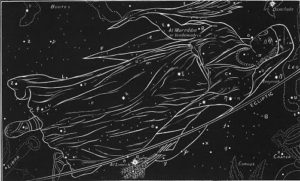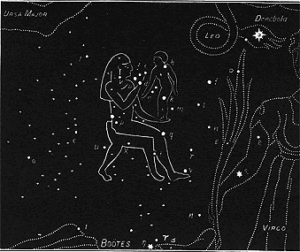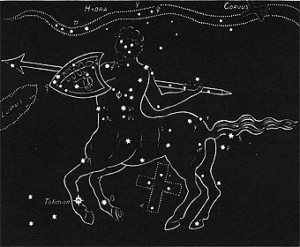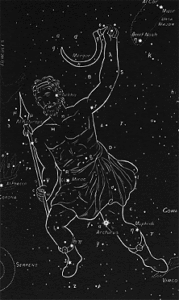The First Book: The Redeemer (His First Coming)
Virgo: The Virgin
Chapter One: The Promised Seed of the Woman
The beginning of all prophecy is in Genesis 3:15. Speaking to the serpent, ADONAI, God states that He will put enmity, or hostility, between Satan and the woman, and between his offspring and hers; He (Christ) will crush your head, and you (Satan) will strike His heel. The name of this sign in Hebrew is Bethulah, which means a virgin, and in the Arabic a branch. This points to the virgin Mary (Matthew 1:23) and the birth of her Son (Isaiah 4:2-6). Another name is Sunbul, Arabic, meaning an ear of corn. Virgo is represented as a woman with a branch in her right hand (Isaiah 11:1) and some ears of corn, pictured as the seed or offspring, in her left hand (Genesis 3:15), thus giving a two-fold testimony of the Coming One, Yeshua Messiah.

There are two important prophecies of the virgin and her Seed. One is connected with the first coming: The virgin will be with Child and will give birth to a Son, and will call Him Immanuel (Isaiah 7:14). The other is connected with His Second Coming: For to us a child is born, to us a son is given, and the government will be on his shoulders. And he will be called Wonderful Counselor, Mighty God, Everlasting Father, Prince of Peace. Of the increase of His government and peace there will be no end. He will reign on David’s throne and over his kingdom, establishing and upholding it with justice and righteousness from that time on and forever. The zeal of the LORD of heaven’s angelic armies will accomplish this (Isaiah 9:6-7). This is only the first chapter in the first of three books, but it contains the outline of the entire whole. The first constellation Coma pictures the first book and Christ’s first coming; the second constellation Centaurus pictures the second book, the Church, the result of the first coming; and the third constellation Bootes pictures the third book, the Messianic Kingdom, the result of the Second Coming.

1. Coma (the desired of all nations): The first constellation in Virgo explains that this coming Branch will be a child.The ancients pictured this constellation as a woman with a child in her arms. But this picture is not found in any modern maps of the stars. Today we find a woman’s wig! In the third century BC, Berenice, the wife of Ptolemy III, king of Egypt, vowed to consecrate her hair to Venus if he returned safely. Her hair, which was hung up in the Temple of Venus, was subsequently stolen, and to comfort her, Conon, an astronomer from Alexandria (283-222 BC), concluded that Jupiter had taken it and made it into a constellation. This is a good example of how the meaning of other constellations have also been perverted. The ancient name for this constellation is Coma, the desired, or the longed for. This is reflected in the Scripture: This is what the LORD of heaven’s angelic armies says: In a little while I will once more shake the heavens and the earth, the sea and the land. I will shake the nations and the desired of all nations will come, and I will fill this house with glory (Haggai 2:7). The next constellation foreshadows the Church, the body of Messiah, made up of Jewish and Gentile believers (Ephesians 2:14), which was a result of His First Coming.

2. Centaurus (the despised sin offering): This is a figure of a being with two natures. Centaurus was the name of the first Centaur in Greek mythology. It was a mythical creature with a human head and torso on top of a horse’s body. But the Hebrew word Bezeh and the Arabic Al Beze both mean the despised. Another Hebrew name was Asmeath, which means a sin offering (Isaiah 53:10). The Greek name was Cherion, which means the pierced, or who pierces (Isaiah 53:5). In the Greek fables Cheiron was renowned for his skill in hunting. He was supposed to be immortal, but he voluntarily agreed to die; and wounded by a poisoned arrow (not intended for him) while in conflict with a wild boar, he transferred his immortality to Prometheus; then he was placed among the stars. Unwittingly, this fable points to Christ, and that having two natures, perfect God and perfect man: He was despised and rejected by men, pierced for our transgressions (Isaiah 53). Then the third constellation of this first chapter goes on to tell of the Messianic Kingdom, which is the result of His Second Coming.

3. Bootes (the destined coming One): This constellation is pictured as a man walking rapidly (Isaiah 63), with a spear in his right hand and a sickle in his left hand. The Greeks called him Bootes, which is from the Hebrew root Bo (to come), meaning the coming. The ancient Egyptians called him Smat, which means one who rules, subdues and governs. They also called him Bau (reminiscent of the more ancient Bo), which also means the coming one. This can be seen in Psalm 96:13: For He comes, He comes to judge the earth. He will judge the world in righteousness and the peoples in His truth. This is the vision that was later shown to John: I looked, and there before me was a white cloud, and seated on the cloud was one “like the Son of Man” with a crown of gold on his head and a sharp sickle in His hand. Then another angel came out of the temple and called in a loud voice to Him who was sitting on the cloud, “Take your sickle and reap, because the time to reap has come, for the harvest of the earth is ripe.” So He who was seated on the cloud swung His sickle over the earth, and the earth was harvested (Revelation 14:14-16). The result of His Second Coming will be the Messianic Kingdom. It will be a thousand years (Revelation 20:2) of peace and righteousness on the earth (see the commentary on Isaiah, to see link click Jg – In Righteousness You Will Be Established, Terror Will Be Far Removed).
This is the conclusion of the first chapter. Here we see the woman whose Seed is to bruise the serpent’s head, the virgin born Branch of the LORD, the perfect God and perfect man who was despised and rejected of men, giving up His life so that others may live. But we also see Him coming afterwards in triumphant power to judge the earth. This is only one chapter out of twelve, but it foreshadows the Messiah’s sufferings and the glorious things to follow in the Messianic Kingdom (First Peter 1:11b CJB).



Leave A Comment